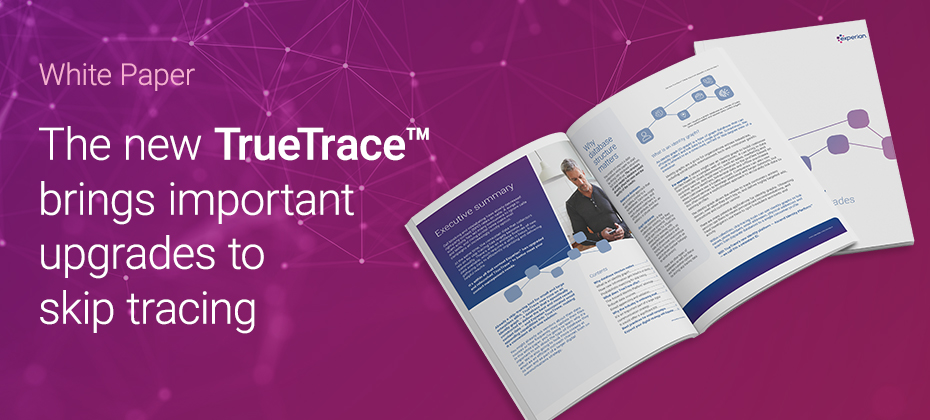Tag: debt

In today's fast-paced world, the ability to locate individuals quickly and accurately is crucial for debt collectors and lenders. Leading skip tracing software is differentiated by data accuracy and data source expansion that delivers increased right-party contact (RPC) rates, better cost efficiency, and improved user experience. The need for improved skip tracing The landscape of skip tracing has changed dramatically in recent years. Call blocking and mislabeling have led to a decline in RPC rates, while increased scam activity has caused many consumers to ignore calls and texts. Additionally, the sheer volume of new information available makes efficiently organizing and delivering helpful results a higher priority than simply gathering data. Here are a few quick stats: Email addresses go stale at a rate of 3% each month There are 820 million changes across all contact databases every 90 days Human errors lead to 50% of data issues, such as a typo that results in a bounced email[1] As a result, we’ve made significant improvements to our skip tracing solution, TrueTrace™. What is TrueTrace? TrueTrace, a powerful skip tracing solution, is a go-to resource for both small and enterprise collectors. For locating hard-to-find individuals, TrueTrace is now even more effective, leveraging advanced technology and more data to enhance its performance. Some organizations that tested TrueTrace saw a 10% lift in RPC rates compared to the competition.[2] Here’s a look at some of the improvements we’ve made: Enhanced data accuracy: TrueTrace now runs on an identity graph to tie data from disparate sources to a unique persistent ID for each consumer. This upgrade improves data matching and accuracy, ensuring that users can rely on the information provided. Expanded data sources: The new version of TrueTrace incorporates email appending, making it a convenient all-in-one solution. By including new and unique data sources, TrueTrace increases hit rates and provides more quality results. With these improvements, here are some potential benefits to your business: Increased RPC rates: Improved data quality and accuracy lead to higher RPC rates, making it easier for collectors to reach the right individuals. Cost efficiency: Reducing operational costs associated with wrong-party contacts and outdated information helps businesses save money and improve their bottom line. Improved user experience: Easier access to accurate data leads to more efficient operations and a better overall user experience. Using an identity graph to organize data points Identity graphs allow organizations to build customer profiles based on a combination of data points. Companies can also use cloud-based services to implement additional, larger sets of data. Within an outreach strategy, skip tracing tools can use identity graphs to associate names, phone numbers, email address, physical address, and assets from multiple, unrelated databases into a single source of accurate information. This can help organizations save time and increase efficiency. Upgrades to skip tracing help businesses enhance efficiency The latest enhancements to TrueTrace represent a significant advancement in skip tracing technology. With upgraded data accuracy, expanded data sources, real-time updates, and flexible integration, TrueTrace offers a comprehensive solution for businesses looking to improve their outreach strategy. This tool can help businesses achieve higher RPC rates, reduce costs, and enhance their overall operational efficiency. To learn more about TrueTrace and its new features, read our latest whitepaper or visit our website or contact us for further inquiries. Discover how TrueTrace can help your business achieve better skip tracing with higher quality results today. Read the whitepaper Visit our website [1] Experian (2023). Revolutionizing your email strategy. [2] Experian TrueTrace data

In today's evolving financial landscape and with delinquincies rising, debt collection remains a critical function for financial institutions. However, traditional methods often fall short in efficiency and customer satisfaction. Enter artificial intelligence (AI), a game-changer poised to revolutionize the debt collection industry. This blog post explores the benefits and uses of AI in debt collection, shedding light on how financial institutions can leverage this technology to enhance their strategies. Understanding AI in debt collection Artificial intelligence – which encompasses machine learning, natural language processing, and other advanced technologies – is transforming various industries, including debt collection. AI in debt collection involves using these technologies to automate and optimize processes, making them more efficient and effective. Examples of AI technologies in debt collection include chatbots, predictive analytics, and automated communication systems. Uses Predictive analytics Predictive debt collection analytics is a powerful tool in AI collections. By analyzing patterns and trends in debtor behavior, AI can forecast the likelihood of repayment. This information allows financial institutions to tailor their collection strategies to individual debtors, improving the chances of successful recovery. Chatbots and virtual assistants AI-powered chatbots and virtual assistants handle routine customer interactions, providing instant responses to common queries. These tools can escalate complex issues to human agents when necessary, ensuring that customers receive the appropriate level of support. By automating routine tasks, chatbots free up human agents to focus on more complex cases. Automated communication AI can automate communication with debtors, sending payment reminders and notifications through various channels such as email, SMS, and phone calls. These messages can be customized based on debtor profiles, ensuring that communication is personalized and effective. Automated communication helps maintain consistent contact with debtors, increasing the likelihood of timely payments. Benefits Improved operational efficiency One of the most significant advantages of AI in debt collection is improved operational efficiency. AI can automate repetitive tasks such as sending payment reminders and processing payments, reducing the need for manual intervention. This automation speeds up the process, reduces costs, and minimizes human errors, ensuring more accurate and timely collections. Enhanced customer experience AI-driven chatbots and virtual assistants can provide personalized communication, enhancing the customer experience. These AI tools are available 24/7, allowing customers to get instant responses to their queries at any time. By offering a seamless and responsive service, financial institutions can improve customer satisfaction and engagement strategies. Better decision making AI collections leverage predictive analytics to assess debtor risk and provide data-driven insights. This information enables financial institutions to develop more effective collection strategies and prioritize high-risk accounts. By making informed decisions based on predictive models, institutions can optimize collections processes and increase their chances of successful debt recovery. Cost savings Automation through AI can lead to significant cost savings. Financial institutions can achieve higher profitability by reducing the need for human intervention and lowering operational costs. Additionally, increased recovery rates due to better cure strategies contribute to overall cost efficiency. Challenges and considerations While AI offers numerous benefits, there are challenges and considerations to keep in mind. Data privacy and security are paramount, as financial institutions must ensure compliance with regulations such as General Data Protection Regulation (GDPR) and California Consumer Privacy Act (CCPA). Balancing automation with the need for a human touch is also crucial, as some customers may prefer interacting with human agents. Additionally, addressing potential biases in AI algorithms is essential to ensure fair and equitable treatment of all debtors. Future Trends in AI and debt collection The future of AI in debt collection looks promising, with emerging technologies poised to make a significant impact. Integration of AI with other technologies such as blockchain and the Internet of Things (IoT) could further enhance the efficiency and security of debt collection processes. As AI continues to evolve, financial institutions must stay abreast of these trends to remain competitive and effective in their collection strategies. Our debt management and collection solutions With more than 25 years of experience and a comprehensive suite of collection products, our enhanced decisioning, improved processes, and account prioritization can enable your organization to move toward a customer-centric approach that helps reduce losses and control costs. AI in debt collection offers a myriad of benefits, from improved efficiency and enhanced customer experience to better decision-making and cost savings. By leveraging AI technologies such as predictive analytics, chatbots, and automated communication, financial institutions can optimize their debt collection strategies and achieve higher recovery rates. As the industry continues to evolve, embracing AI will be crucial for financial institutions looking to stay ahead of the curve. Click below to learn more about how we can help your organization optimize your debt collection strategies to lose less and recover more. Learn more Watch our webinar on-demand This article includes content created by an AI language model and is intended to provide general information.

This article was updated on August 9, 2023. Debt collections can be frustrating — for both consumers and lenders alike. Coupled with ever-changing market conditions and evolving consumer expectations for their digital experience, lending institutions and collections agencies must develop the right collections strategies to reduce costs and maximize recovery rates. How can they do this? By following the three Cs — communication, choice and control. Communication To increase response rates and successfully retrieve payments, lenders must cater to consumers’ preferences for communication, or more specifically, make the right type of contact at the right time. With debt collection predictive analytics, you can gain a more holistic view of consumers and further insight into their behavioral and contact channel preferences. This way, you can better assess an individual's propensity to pay, determine the best way and time to reach them and develop more personalized treatment strategies. Control Debt collection solutions that provide a more comprehensive customer view can also give individuals greater control as they’re able to engage with collectors via a channel that may be easier or more comfortable for them than a phone call, such as email, text or chatbots. Providing consumers with various options is especially important as 81% think more highly of brands who offer multiple digital touchpoints. To further improve your methods of communication, consider streamlining monotonous processes with collection optimization. By automating repetitive tasks and outreach, you can reduce errors and free up your agents’ time to focus on accounts that need more attention, creating a customer-centric collections experience. Choice Ultimately, the success of collections initiatives relies heavily on how well collection practices are accepted and adopted by the end user. Consumers want to make informed decisions and want to be offered choices – therefore giving them more control in a decision-making process and with their finances. “Consumers have made a monumental shift to digital. To enhance your collections performance, it is critical to engage consumers in the method and channel of their choosing,” said Paul Desaulniers, Head of Scoring, Alternative Data and Collections at Experian. Lending institutions and third-party collection agencies that are able to communicate across all consumer channels will see more success in their collections strategies. Are your debt collection tactics and strategies up-to-par? READ: Strengthening Your Debt Collection Strategy Improve your collections strategy By catering to consumers’ communication preferences, giving them control and offering them choices, financial institutions and collections agencies can more effectively reach their customer base, with less effort. It’s a win-win for all. Experian offers various debt management and collections systems that can help you optimize processes, reduce costs and increase recovery rates. To get started, visit us today. Learn more

Earlier this year, the Consumer Financial Protection Bureau (CFPB) issued a Notice of Proposed Rulemaking (NPRM) to implement the Fair Debt Collection Practices Act (FDCPA). The proposal, which will go into deliberation in September and won't be finalized until after that date at the earliest, would provide consumers with clear-cut protections against disturbance by debt collectors and straightforward options to address or dispute debts. Additionally, the NPRM would set strict limits on the number of calls debt collectors may place to reach consumers weekly, as well as clarify how collectors may communicate lawfully using technologies developed after the FDCPA’s passage in 1977. So, what does this mean for collectors? The compliance conundrum is ever present, especially in the debt collection industry. Debt collectors are expected to continuously adapt to changing regulations, forcing them to spend time, energy and resources on maintaining compliance. As the most recent onslaught of developments and proposed new rules have been pushed out to the financial community, compliance professionals are once again working to implement changes. According to the Federal Register, here are some key ways the new regulation would affect debt collection: Limited to seven calls: Debt collectors would be limited to attempting to reach out to consumers by phone about a specific debt no more than seven times per week. Ability to unsubscribe: Consumers who do not wish to be contacted via newer technologies, including voicemails, emails and text messages must be given the option to opt-out of future communications. Use of newer technologies: Newer communication technologies, such as emails and text messages, may be used in debt collection, with certain limitations to protect consumer privacy. Required disclosures: Debt collectors will be obligated to send consumers a disclosure with certain information about the debt and related consumer protections. Limited contact: Consumers will be able to limit ways debt collectors contact them, for example at a specific telephone number, while they are at work or during certain hours. Now that you know the details, how can you prepare? At Experian, we understand the importance of an effective collections strategy. Our debt collection solutions automate and moderate dialogues and negotiations between consumers and collectors, making it easier for collection agencies to reach consumers while staying compliant. Powerful locating solution: Locate past-due consumers more accurately, efficiently and effectively. TrueTraceSM adds value to each contact by increasing your right-party contact rate. Exclusive contact information: Mitigate your compliance risk with a seamless and unparalleled solution. With Phone Number IDTM, you can identify who a phone is registered to, the phone type, carrier and the activation date. If you aren’t ready for the new CFPB regulation, what are you waiting for? Learn more Note: Click here for an update on the CFPB's proposal.

Have you seen the latest Telephone Consumer Protection Act (TCPA) class action lawsuit? TCPA litigations in the communications, energy and media industries are dominating the headlines, with companies paying up to millions of dollars in damages. Consumer disputes have increased more than 500 percent in the past five years, and regulations continue to tighten. Now more than ever, it’s crucial to build effective and cost-efficient contact strategies. But how? First, know your facts. Second, let us help. What is the TCPA? As you’re aware, TCPA aims to safeguard consumer privacy by regulating telephone solicitations and the use of prerecorded messages, auto-dialed calls, text messages and unsolicited faxes. The rule has been amended and more tightly defined over time. Why is TCPA compliance important? Businesses found guilty of violating TCPA regulations face steep penalties – fines range from $500 to $1500 per individual infraction! Companies have been delivered hefty penalties upwards of hundreds of thousands, and in some cases, millions of dollars. Many have questions and are seeking to understand how they might adjust their policies and call practices. How can you protect yourself? To help avoid risk for compliance violations, it’s integral to assess call strategies and put best practices in place to increase right-party contact rates. Strategies to gain compliance and mitigate risk include: Focus on right and wrong-party contact to improve customer service: Monitoring and verifying consumer contact information can seem like a tedious task, but with the right combination of data, including skip tracing data from consumer credit data, alternative and other exclusive data sources, past-due consumers can be located faster. Scrub often for updated or verified information: Phone numbers can continuously change, and they’re only one piece of a consumer’s contact information. Verifying contact information for TCPA compliance with a partner you can trust can help make data quality routine. Determine when and how often you dial cell phones: Or, given new considerations proposed by the CFPB, consider looking at collections via your consumers’ preferred communication channel – online vs. over the phone. Provide consumers user-friendly mechanisms to opt-out of receiving communications At Experian, our TCPA solutions can help you monitor and verify consumer contact information, locate past-due consumers, improve your right-party contact rates and automate your collections process. Get started

Debt management is becoming increasingly complex. People don’t answer their phones anymore. There are many, many communication channels available (email, text, website, etc.) and just as many preferences from consumers regarding how they communicate. Prioritizing how much time and effort to spend on a debtor often requires help from advanced analytics and machine learning to optimize those strategies. Whether you are manually managing your collections strategies or are using advanced optimization to increase recovery rates, we’ve got keys to help you improve your recover rates. Watch our webinar, Keys to unlocking debt management success, to learn about: Minimizing the flow of accounts into collections and ensuring necessary information (e.g. risk, contact data) is used to determine the best course of action for accounts entering collections Recession readiness – prepare for the next recession to minimize impact Reducing costs and optimizing collections treatment strategies based on individual consumer circumstances and preferences Increasing recovery rates and improving customer experience by enabling consumers to interact with your organization in the most effective, efficient and non-threatening way possible Watch on-demand now>

With the new year just days behind us, and as the uptick in holiday spending comes back down, debt consolidation will take precedence along with the making (and breaking) of new year’s resolutions. Personal loans were the fastest growing unsecured lending product for much of last year. From debt consolidation to major purchases, consumers are increasingly choosing these flexible, easy-access loans over credit cards throughout the course of the year. Recent Experian research highlighted the trends around this fast-paced lending product: Previously, while industry experts had predicted a leveling off of personal loans originations, Experian data shows steady growth. Additionally, there were 35.7 million personal loan trades in the second quarter, the highest number to date since Q1 of 2007. What is driving this growth? Observations suggest growth trends across the industry as a whole – not just in the personal loans segment. And the numbers prove it. Growth is occurring across the board. Experian statistics show: Consumer confidence is up 5.6% year over year Investor confidence remains high – up 18% year over year since 1987 Unemployment remains low and continued decrease is forecasted in the near future With increased confidence and increased spending often comes increased personal loans. More financial institutions are bringing personal loans under their roofs. As many consumers enter each new year as part of a “debt consolidation nation” per se, focus for many will be on personal loans as they seek to consolidate revolving debt. Since this is a known trend, lenders across the board – from traditional financial institutions to fintechs – need to be strategic with their marketing efforts in order to reach the right consumers with the right products at the right time. Consumers consider important factors in choosing the lender(s) for their personal loans including interest rate and the ability to apply online among others. These factors see differences across generations as well. These factors and others should influence lenders’ marketing strategies, on top of their best practices. Experian partnered with Mintel Group for their insights on the 2019 trends and best practices for digital credit marketing. Register for our upcoming webinar to learn more about Digital Credit Marketing 2019 Trends and Best Practices. Register for the Webinar

Ben Franklin was wrong. Death and taxes are not the only two constants in life. For many, debt makes a third. And where there is past-due debt, collections is not far from the conversation, if not included in the same breath. While the turn of the new year may mark some arduous work to be done – losing those holiday pounds, spring cleaning, balance transfers and tax filings – there’s also opportunity for lenders, collectors and consumers alike. Just as the spikes in retail trends are analogous with the holiday months, there’s an evident uptick in collections during tax season year after year. As such, successful lenders, financial institutions and collections agencies know that January, February and March are critical months to engage with past-due customers, specifically as they relate to the tax season. The average tax refund for 2016 and 2017 was $2,860 and $2,769 respectively, according to the IRS. And while some may assume that all consumers look at this money as an opportunity for a “treat yourself” splurge, 35% of consumers expecting a refund said they would use it to pay down debt, according to the National Retail Federation. Additionally, during the 2017 tax season, 45 million consumers paid at least $500 and 10% or more of a tradeline balance(s), according to Experian data. So, if past-due consumers want to pay down debt, and the ultimate goal of collections is to recoup over-due funds, and first quarter collections growth appears to be driven by tax refunds, how do we make the connection? Think of the scene from Jerry Maguire – “Help me, help you!” Help consumers help themselves. Experian’s new Tax Season Payment IndicatorTM examines payment behavior over the past two years to determine whether a consumer has made a large payment to a tradeline balance – or balances – during tax season. “Millions of consumers used their tax refunds to pay down debt and many plan to do it again,” said Denise McKendall, Product Manager. “Collectors that leverage previous tax season payment behavior to identify and strategically engage with this group will benefit the most from the tax refund season.” Engaging this information can be like having a collections crystal ball. Targeting consumers that are likely to use their refund to pay down debt can influence messaging, campaign refinement and the timeliness of your touchpoints, resulting in greater collections ROI. This means as the year closes out and planning begins for 2019, collections prioritization strategy is key. And those conversations should be taking place now. Are you tax season ready? Learn More About Tax Season Payment Indicator

The holidays can be a stressful time for consumers — and an important time for lenders to anticipate the aftermath of big credit card spending. According to our recent study with Edelman Intelligence: 56% of respondents said holiday shopping puts a strain on their finances. 43% said the stress of holiday shopping makes it difficult to enjoy the season. With the holiday shopping season over, those hefty credit card statements are coming soon. Now is the time for lenders to prepare for the January and February consolidations. Want to know more?

A recent Experian credit trends study showcases the types of debts Americans have, the amounts they owe and the differences between generations. Nationally, the average debt in the United States is $78,030 and the average VantageScore® credit score is 751. The debt and VantageScore® credit score distribution for each group is listed below, with the 30 to 46 age group carrying the most debt and the youngest age group (19 to 29) carrying the least: Age group Average debt Average VantageScore® credit score 66 and older $38,043 829 47 to 65 $101,951 782 30 to 46 $111,121 718 19 to 29 $34,765 672 Get your VantageScore® credit score here Source: To view the complete study, please click here VantageScore® is owned by VantageScore Solutions, LLC

Findings from the Q2 Experian Business Benchmark Report showed that the amount of delinquent debt has increased significantly for the largest and smallest businesses. Very large businesses (those with more than 1,000 employees) had the greatest shift in percentage of dollars delinquent, shifting from 11.6 percent in June 2010 to 18.2 percent in June 2011, and very small businesses (those with one to four employees) had the greatest shift in percentage of dollars considered severely delinquent, increasing from 9.9 percent to 11.7 percent year over year. Conversely, the Q2 report indicated that mid-size businesses (those with 100 to 249 employees) have shown the greatest improvement in percentage of dollars delinquent and severely delinquent, reducing their debt by as much as 7.3 percent and 35.8 percent, respectively, year over year. Download previous reports and view a visual representation of this data broken down by state in an interactive map. Source: Download the current Business Benchmark Report